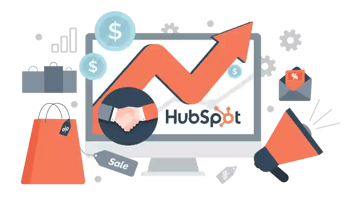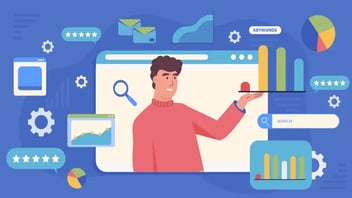How to Build a Successful Sales Enablement Strategy From Scratch
Research shows that effective sales enablement strategies can generate a staggering 49% win rate on forecasted deals. But what exactly is "sales enablement?" It's about equipping your sales team with the resources they need to succeed–from content and training to the right tools and processes.
Whether you're a startup or an enterprise, a solid sales enablement strategy can be a game-changer, driving revenue, boosting efficiency, and creating a winning sales culture.
Sales enablement is the strategic, ongoing process of equipping your sales team with the resources they need to consistently close more deals. Think of it as providing your sales force with the best tools, training, and content to engage buyers and win throughout the customer journey.
But even your top-performing sales reps can't consistently hit their targets without a well-defined strategy guiding their efforts. Let's break down the key steps to building a successful sales enablement strategy from the ground up.
Pre-Planning: Before the Strategy
Diagnose Your Sales Performance with a Needs Analysis
Before diving headfirst into creating your sales enablement strategy, it's crucial to take a step back and assess the current landscape. A comprehensive needs analysis acts as your compass, guiding you toward the areas where enablement can make the biggest impact.
Think of it as a diagnostic checkup for your sales process. This involves gathering data and insights to pinpoint your team's strengths, weaknesses, and areas ripe for improvement. How do you go about this? Consider these methods:
-
Surveys: Gather quantitative and qualitative data from your sales team about their challenges, needs, and perceptions of available resources.
-
Interviews: Conduct one-on-one conversations with sales reps, managers, and even customers to gain deeper insights into pain points and opportunities.
-
Observation: Shadow sales reps during their daily activities, such as sales calls and presentations, to observe their workflows and identify areas for optimization.
By analyzing this information, you can identify skill gaps, content deficiencies, technological hurdles, and process bottlenecks hindering your sales team's performance. But that's not all–your needs analysis should also consider the bigger picture. Ensure your sales enablement strategy aligns with your organization's overarching business goals and sales objectives.
Set Your Sights on SMART Goals
With a clear understanding of your needs, it's time to set your sights on well-defined goals. Avoid vague ambitions like "improve sales performance." Instead, embrace the SMART approach:
-
Specific: Clearly define what you want to achieve. (e.g., "Increase the number of qualified leads generated each month.")
-
Measurable: Establish metrics to track progress. (e.g., "Increase the lead-to-opportunity conversion rate by 10%.")
-
Achievable: Set realistic and attainable goals.
-
Relevant: Ensure goals align with overall business objectives.
-
Time-bound: Define a timeframe for achieving the goals. (e.g., "Achieve a 5% increase in average deal size within the next quarter.")
These SMART goals will serve as your north star, guiding your enablement initiatives and providing a benchmark for measuring success. To keep things on track, establish key performance indicators (KPIs) that align with your goals. Track metrics like revenue growth, deal size, sales cycle length, and lead conversion rates to monitor progress and make data-driven adjustments along the way.
How to Develop a Comprehensive Sales Enablement Plan
1. Content Development and Management
Not just any content will do if you're looking to truly enable your sales team to succeed. After all, your sales enablement strategy hinges on providing your team with high-quality, relevant materials that resonate with your target audience and address their specific needs and pain points. Think of it as arming your sales force with valuable tools to engage prospects, build relationships, and guide them through the buyer's journey.
What kind of content should you create? The possibilities are vast, but staples include blog posts, white papers, case studies, and sales decks. However, today's buyers demand personalized, interactive, and insightful content that addresses their specific needs and challenges.
Here's how you can elevate your content strategy and leverage advanced techniques that will set your sales team apart:
-
Interactive content: Move beyond passive content consumption and create interactive experiences that engage buyers and encourage active participation. Think assessments, calculators, configurators, and virtual reality demos that allow buyers to explore your products and solutions in a dynamic and personalized way.
-
Example: Develop an interactive ROI calculator that allows prospects to input their specific business data and see the potential return on investment from implementing your solution.
-
-
Hyper-personalized content: Leverage AI and machine learning to deliver content that's tailored to each buyer's unique profile, interests, and stage in the buyer's journey. Imagine a prospect receiving a case study featuring a company strikingly similar to their own or a proposal that automatically adjusts pricing based on their specific needs.
-
Example: Utilize a content personalization engine that pulls data from your CRM and marketing automation platform to automatically generate customized sales presentations, proposals, and email sequences.
-
-
Content intelligence: Implement content analytics to track content performance, understand buyer engagement, and identify areas for improvement. Go beyond basic metrics like downloads and page views and delve into deeper insights like time spent on page, scroll depth, and heatmaps to understand how buyers are truly interacting with your content.
-
Example: Use content intelligence tools to identify which content pieces are most effective at moving buyers through the sales funnel and optimize your content strategy accordingly.
-
But creating great content is only half the battle. You also need an efficient system to manage and distribute it. A centralized content management system (CMS) acts as your content hub, making it easy for sales reps to find, access, and share the right materials at the right time. This ensures consistency, saves time, and empowers your team to deliver a seamless and personalized buyer experience.
2. Sales Training and Coaching
Even the most talented salespeople need ongoing training and coaching to stay sharp and adapt to the ever-evolving sales landscape. Your sales enablement strategy should prioritize continuous learning and development to equip your team with the knowledge, skills, and confidence they need to excel.
Consider these areas for sales training:
-
Product knowledge: Ensure your sales team has a deep understanding of your products or services, their features, benefits, and applications.
-
Sales techniques: Provide training on effective sales methodologies, such as SPIN selling, Challenger Sale, or Sandler Training, to help reps navigate complex sales cycles and close more deals.
-
Communication skills: Hone communication skills, including active listening, questioning techniques, and presentation skills, to foster stronger customer relationships.
-
Negotiation tactics: Equip your team with effective negotiation strategies to navigate pricing discussions, handle objections, and secure favorable outcomes.
But don't limit yourself to traditional classroom-style training. To truly empower your sales team, adopt a more holistic approach that focuses on developing critical skills and fostering continuous improvement.
-
Advanced sales methodologies: Go beyond basic sales training and equip your team with advanced sales methodologies that address the complexities of the modern buying process. Explore concepts like Challenger Sale, MEDDIC, and Value Selling to help your reps navigate complex sales cycles, handle objections, and build stronger customer relationships.
-
Situational sales training: Provide training scenarios that simulate real-world sales situations, allowing reps to practice their skills and receive feedback in a safe and controlled environment. Utilize role-playing, simulations, and virtual reality to create immersive learning experiences that enhance knowledge retention and improve performance.
-
Data-driven coaching: Leverage sales performance data and analytics to provide personalized coaching and feedback to individual reps. Identify areas where each rep excels and areas where they need improvement, and tailor your coaching approach accordingly.
3. Sales Tools and Technology
The right sales tools can significantly enhance your team's productivity, efficiency, and effectiveness. But with so many options available, it's crucial to select the tools that best align with your specific needs and integrate seamlessly with your existing systems.
Here are some essential sales tools to consider:
-
Customer Relationship Management (CRM) Software: A CRM system acts as a central hub for managing customer interactions, tracking deals, and organizing sales data. It provides valuable insights into customer behavior and helps sales reps personalize their approach.
-
Sales intelligence platforms: These platforms provide valuable data and insights about prospects and customers, helping sales reps identify key decision-makers, understand their needs, and tailor their outreach.
-
Marketing automation tools: Marketing automation platforms help automate repetitive tasks, such as email marketing and lead nurturing, freeing up sales reps to focus on high-value activities like building relationships and closing deals.
-
Sales engagement platforms: These platforms help streamline sales communication and automate outreach, enabling reps to connect with more prospects and personalize their messaging.
Plus, some more advanced options:
-
AI-powered sales tools: Embrace the power of artificial intelligence (AI) to automate tasks, provide insights, and personalize the buyer experience. Explore tools like AI-powered sales assistants, predictive analytics platforms, and conversation intelligence software to gain a competitive edge.
-
Sales enablement platforms: Invest in a comprehensive sales enablement platform that provides a centralized hub for content management, training delivery, and sales performance tracking. These platforms can streamline your sales enablement efforts, improve collaboration, and provide valuable insights into your team's performance.
-
Mobile-first sales tools: Empower your sales team with mobile-first tools that allow them to access information, complete tasks, and engage with buyers from anywhere, at any time. Ensure your CRM, content library, and other essential tools are optimized for mobile devices to support a flexible and productive workforce.
Investing in these tools is only the first step. Ensure your sales team receives adequate training and support to effectively utilize these technologies and integrate them into their daily workflows.
4. Sales Process Optimization
Your sales process is the roadmap that guides your sales team from initial contact to closed deal. A well-defined and optimized sales process ensures consistency, reduces friction, and improves overall sales performance. As part of your sales enablement strategy, take a critical look at your existing sales process and identify areas for improvement. But remember, a one-size-fits-all sales process is no longer effective.
Consider these strategies for sales process optimization:
-
Streamline lead qualification: Implement a clear and consistent lead qualification process to ensure sales reps are focusing their efforts on the most promising prospects.
-
Predictive sales analytics: Leverage predictive analytics to identify potential roadblocks, forecast deal outcomes, and prioritize sales efforts. Use data to identify deals that are at risk of stalling and proactively implement strategies to get them back on track.
-
Dynamic sales playbooks: Move beyond static sales playbooks and create dynamic playbooks that adapt to the specific context of each deal. Utilize AI and machine learning to recommend the most effective sales strategies, content, and resources based on the specific characteristics of the buyer and the stage of the sales cycle.
-
Continuous process improvement: Adopt a culture of continuous process improvement by regularly evaluating your sales process, gathering feedback from your sales team, and implementing data-driven adjustments. Embrace agile methodologies to iterate on your sales process and ensure it remains aligned with your business goals and customer needs.
By implementing these advanced strategies, you can transform your sales enablement program into a powerful engine for growth, empowering your sales team to achieve peak performance and drive exceptional results.
Fueling Sales Success: Your Next Steps
A robust sales enablement strategy is no longer a luxury—it's a necessity. By equipping your sales team with the right content, training, tools, and processes, you can empower them to achieve peak performance, drive revenue growth, and build stronger customer relationships.
Remember, sales enablement is an ongoing journey, not a destination. Continuously evaluate your strategy, gather feedback from your sales team, and adapt to the ever-evolving needs of your buyers.
If you're ready to take your sales enablement efforts to the next level, Aspiration Marketing can help. Our team of experts can assist you with every stage of your sales enablement journey, from conducting a needs analysis and developing a comprehensive strategy to implementing cutting-edge tools and providing ongoing support.
Ready to transform your sales organization?
This content is also available in:
- German: Strategie zur Vertriebsförderung: Erfolgsfaktoren und Umsetzungstipps
- Spanish: Cómo crear una estrategia de capacitación de ventas exitosa desde cero
- French: Comment élaborer une stratégie d'aide à la vente à partir de zéro ?
- Italian: Strategia di abilitazione vendite: guida completa per iniziare da zero
- Romanian: Strategie de vânzări: cum o creezi de la zero
- Chinese: 如何从零开始构建成功的销售促进战略

Joachim is a certified HubSpot trainer with over 13 years of experience in content marketing, strategy, website development, and SEO. He has implemented numerous large-scale, international growth marketing programs, including one with UiPath, which grew from a startup to a successful IPO on the NYSE. Joachim has special expertise in multilingual marketing and sales enablement projects, and he uses the latest AI technologies to help our clients.






.webp?width=352&name=Blog_WBM_Platforms%20for%20Engaging%20Your%20Audience%20(1).webp)


Leave a Comment